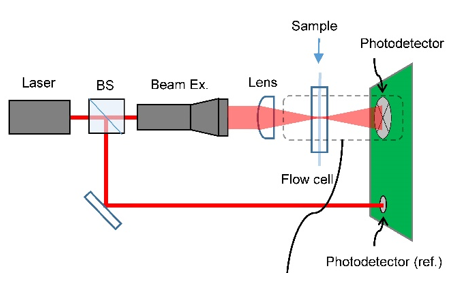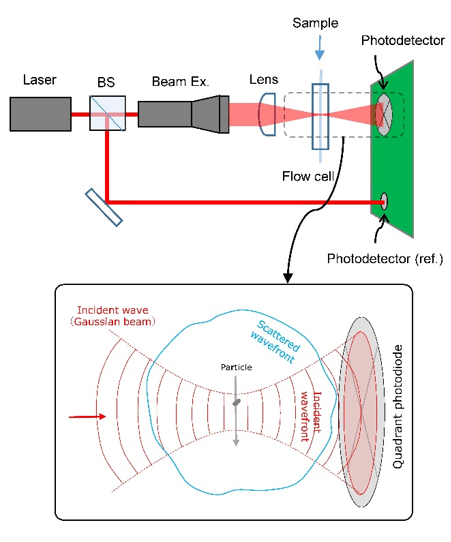Microscopic measurements Researcher creates a new way to count and identify microscopic particles in fluids

A new method is proposed to automate the measurement of nano to microscale particles suspended in fluid. The single particle extinction and scattering (SPES) method can accurately determine the material properties and size distribution of individual particles. A broad range of research disciplines could make use of such rapid and simple automated particle identification.
The smaller things are, the harder it is to count and measure them. This is especially true for biological or chemical particles, where some methods to do so can disrupt the measured sample, which might not be desirable. Project Researcher Nobuhiro Moteki from the Department of Earth and Planetary Science at the University of Tokyo has devised a way to count and identify particles in a fluid accurately and without disruption. And this method could prove useful to many researchers in many different fields.

A schematic to show how the SPES method is performed. Image: © 2020 Nobuhiro Moteki
“The automated measurement of nano to microscale particles in fluids is an important stage in many kinds of research,” said Moteki. “Environmental science, nanomaterial engineering, purification technology for air, water and chemical solvents, biomedical research, etc. However, there have been no automated particle measurement methods for simultaneously determining both composition and size of individual particles. Until now.”
SPES is elegantly simple in design, but proved extremely demanding to devise due to the amount of variables involved, which leads to a complicated calibration process. There’s also a high degree of computation involved so reliable algorithms had to be created. But essentially, the process involves shining a specific kind of laser through a small sample of fluid. The light scatters differently depending on particles it encounters on its way to a sensor. The sensor data is then analyzed to determine what kinds of particles the light must have passed through.
“This method detects the amplitude and phase properties of the light field scattered by individual particles illuminated by a focused laser beam,” explained Moteki. “Then, the measurement signals are analyzed according to a special mathematical and physical theory for estimating the various physical properties of unknown particles.”
In environmental sciences, nano to microscale particles and pollutants in the atmosphere and ocean play important roles for climate change and the sustainability of ecosystems. However, nano to microscale particles are very difficult to quantify using existing analytical methods because they always exist as a complex mixture of unknown materials of various size distributions. But if SPES is further developed and adopted, it could accelerate much research in this and other fields.
“It took about three and a half years to come up with the fundamental idea and a practical algorithm for quantitative estimation of refractive index and size distribution of particles,” concluded Moteki. “It’s exciting to think that SPES could be used by researchers for medical, environmental, engineering and other purposes, too.”
Papers
Nobuhiro Moteki, "Capabilities and limitations of the single-particle extinction and scattering method for estimating the complex refractive index and size-distribution of spherical and non-spherical submicron particles," Journal of Quantitative Spectroscopy and Radiative Transfer: December 20, 2019, doi:10.1016/j.jqsrt.2019.106811.
Link (Publication )
)





